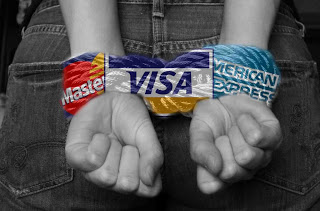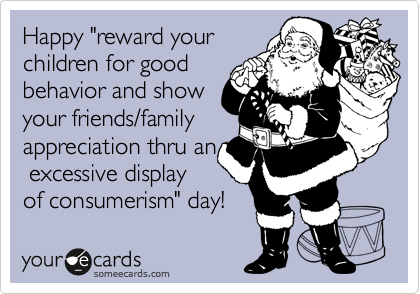 Everyone runs up a little credit card debt, right? A personal loan or two?
Everyone runs up a little credit card debt, right? A personal loan or two?
I reckon that’s what many people tell themselves to justify carrying heavy debt, however the simple fact is that out-of-control spending and poor credit card management are serious problems that are not sustainable and have to be tackled head-on. It’s not limited to credit cards, but that’s what I will mainly focus on within this post.
A recent study by Barclays uncovered some shocking statistics. They found that,
“Australian households are the most indebted in the world, according to research by Barclays, which warns that the country would be vulnerable in the event of another global financial shock. When it comes to household debt – which includes mortgages, credit cards, overdrafts and personal loans – Australia leads the global field, with credit continuing to pile up while the rest of the developed world is paying it down.”
The signs are all around us that this can’t continue for very much longer. Local shop fronts empty for much longer than usual, people using food banks more frequently, continued rampant spending at all times of the year and not just Christmas, and people just living for the moment and not thinking what the future may bring.
I blame this partly on our consumer culture and a Veruca Salt mentality, so therefore individuals should be educated to be more aware of the traps and pitfalls to avoid when it comes to their personal finances.
So, with that in mind I have looked back at our experiences so that I could document the 6 warning signs that your debt may be out of control, and what you may be able to do to get back in check. Not all of these things have happened to us, but we have close friends that we’ve helped who nearly went all the way, so to speak.
Just so you know, I am not a financial planner, nor able to give specific financial advice. The list below is just common sense ways to get your spending back in control.
1. You Pay for Everything with Credit Cards
You used cash when buying groceries, filling up the car, or to pick up a quick takeaway, but now you whip out the credit card for virtually all your regular daily purchases. If this sounds familiar, you are probably either in trouble or on the verge of it. While plastic is easy to use, the credit card balances you are building will come back to haunt you. If you are already carrying a large balance on your card, your new purchases will likely just hike up the amount of interest you’ll be charged each month. Paying off the minimal amount will not get you out of debt anytime soon.
Keep that in mind when you’re making your next purchase. It may help change your habits. And if you’re relying on credit because you just don’t have the cash, it’s time to take a realistic look at your budget and consider taking necessary changes.
2. You’re Adding New Accounts
What happens if you can’t pay your credit card or other bills? Some people may try to solve this problem by opening up new credit card accounts and using balance transfers to zero interest cards, or take cash advances to make required payments on their existing debt. They might also add a new account if their old cards have reached their credit limits.
This may solve the immediate problem, but it also digs you deeper into debt. If you’re in this position, it’s a sure sign that you need to get a handle on your debt and alter your spending habits as soon as possible.
3. Your Debt’s Just Getting Bigger
Here’s a sad fact: Even if you don’t keep spending and stop right now, your outstanding credit card balances may keep growing if you make only the minimum payment each month. That’s because the interest rate you owe on your outstanding debt is lumped in with your balance and grows. You then have to pay interest not only on your past purchases but also on that added interest.
Once again, it is time to get real and write down your income and outgoings in a budget plan that will help you to get your head above water and start paying down the debts.
4. You’re Missing Payments Each Month
Missed payments help no-one, and the added stigma increases your unhappiness and affects your capability to think straight. If you get to this stage all is not lost. Ask for help from your creditors, whether it be your bank, building society, or energy/phone company. Remember that it’s always a good idea to contact your creditors as soon as you can when find that you can’t make a payment and ask about temporary reduced payment plans, or other options. This step could help you prevent a bad credit rating or cancelled account, or even the threat of court action.
5. You Avoid Paying Your Bills
You have a stack of unpaid bills that just keeps growing. You screen phone calls or hide behind the lounge chair so you don’t have to talk to angry and persistent bill collectors.
If you’re in this situation, you won’t be able to sidestep the problem forever. You need to get a realistic sense of where you stand financially and begin contacting creditors, cutting you spending or taking other necessary steps (filing for bankruptcy) to get your financial life back on track.
6. Address the Root Cause
Spending more than you earn is the root cause and the path to misery. It is as simple as that. I once learnt this basic financial rule from a wise author the following quote;
“Annual income twenty pounds, annual expenditure nineteen six, result happiness. Annual income twenty pounds, annual expenditure twenty pound ought and six, result misery.”― Charles Dickens, David Copperfield
We’ve been there, we know. At one stage our credit card debt was over $23,000 at 18% interest. We just couldn’t get ahead in life. We were chasing the almighty dollar, thinking that the more material things I owned, the happier I would be. It doesn’t work that way. In hindsight we were very, very sad.
What saved us was setting a budget and we began to live within our means. It was one of the reasons we chose to adopt a more sustainable lifestyle. We know we couldn’t save the planet, if we couldn’t save ourselves from debt first.
Drafting a Budget
Setting a budget (yes I know it’s a dirty word for some) is the only way you will know if you incoming earnings and spending match or preferably you have a little bit left over that you can begin to pay down your debts. Once your creditors have been contacted, most will allow you to start a payment plan that will go a long way to getting back in control. You may have to seek financial advice to roll all your debts into one single low-interest loan so that you can spread the payments.
You can find a very simple and easy to use budget calculator over on the ASIC MoneySmart website. This site is a wealth of information which you can learn so much about personal finance matters. It is my go-to site if I need learn anything moneywise. Best of all, it’s free.
Shake the Consumer Tag
If you use it, it will help you to discover where the unplanned spending is occurring. Once you figure that out, it is as simple as reducing your spending or begin selling off unnecessary stuff to pay down those burdening debts.
Note; I haven’t used the label of consumer during this entire post until now. I believe that because we were not born with this label, it shouldn’t be used. We are just ordinary people trying to find our way in the scheme of things. This label is one given to society as a whole by the media. I detest it.
So friends, what do you say? Have you ever paid off large amounts of debt and got back on track? How did you do it?

 Now, wait a minute. There is that economic growth example gets thrown around a lot of late. All forms of government seem to keep telling us that we must stimulate the economy, and increase economic growth. But doesn’t growth mean destroying, sorry, squandering the remaining resources we have left on the planet? That can’t be a good thing, can it? More on that in another post though. Lets get back to the subject of Christmas.
Now, wait a minute. There is that economic growth example gets thrown around a lot of late. All forms of government seem to keep telling us that we must stimulate the economy, and increase economic growth. But doesn’t growth mean destroying, sorry, squandering the remaining resources we have left on the planet? That can’t be a good thing, can it? More on that in another post though. Lets get back to the subject of Christmas.